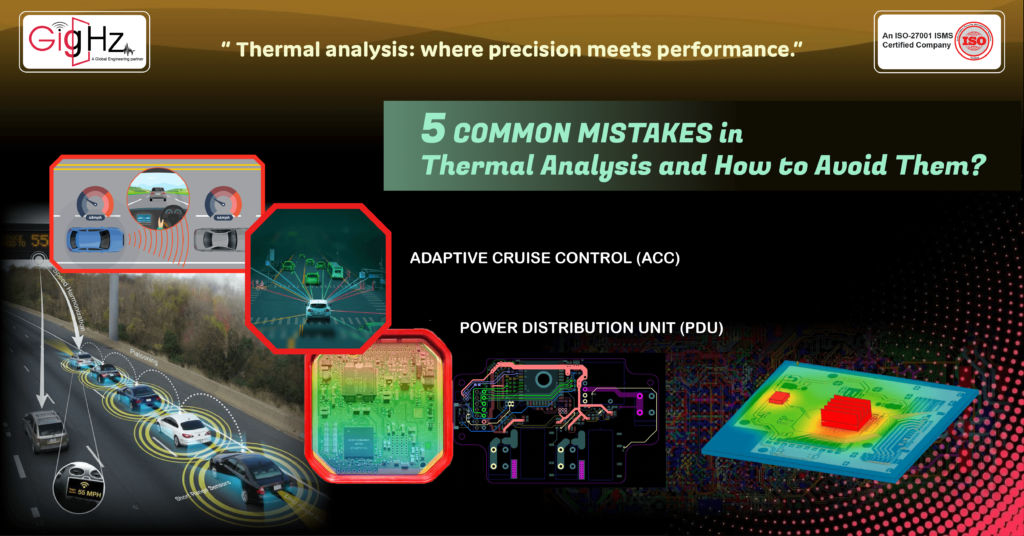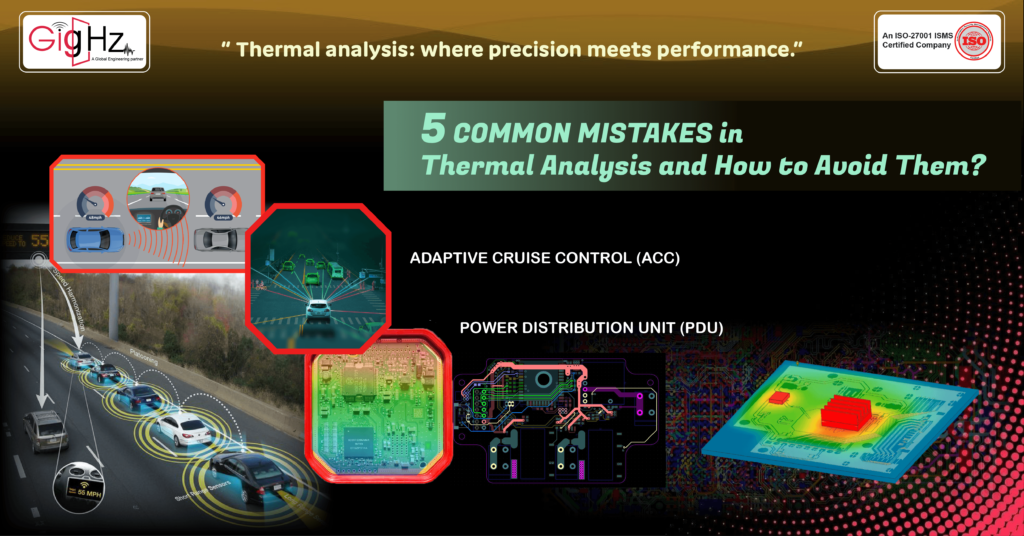5 Common Mistakes in Thermal Analysis and How to Avoid Them?
- Posted On:
- August 28, 2024
- Category:
- Analysis & Simulation

PCB Thermal Analysis
Think of where cars have come from:
Starting as simple horse-drawn carriages, they’ve evolved into the sophisticated vehicles we drive today.
One standout feature of modern cars is adaptive cruise control (ACC), which uses sensors and cameras to automatically adjust your car’s speed based on the traffic around you.
It’s like having a smart co-pilot that helps maintain safe distances on the road.
But behind the scenes, powering this advanced technology and ensuring it works flawlessly is a crucial component known as the Power Distribution Unit (PDU).
The PDU manages the flow of electricity throughout your car, making sure each system, including ACC, gets the right amount of power.
As cars become more advanced and packed with electronics, managing power and heat effectively is critical.
This is where thermal analysis comes in.
The PDU not only distributes power but also needs to handle heat generated by all these electronic components.
Without proper thermal management, excessive heat can damage sensitive components and affect performance.
Thermal analysis helps in designing PDUs that can effectively dissipate heat and prevent overheating, ensuring that all systems remain reliable and function smoothly.
In short, the PDU and thermal analysis work together to keep everything in your car running efficiently, making them key players in the transition from horse-drawn carriages to today’s high-tech vehicles.
Let’s dig in!
5 Common Mistakes in Thermal Analysis and How to Avoid Them?

When designing Power Distribution unit (PDU) PCBs, addressing heat dissipation is critical.
1. Inadequate Heat Dissipation
Failing to incorporate or properly size heat sinks can lead to inadequate heat dissipation. This mistake can cause components to overheat, leading to potential failures and reduced lifespan.
Not using enough thermal vias or making them too small can hinder heat transfer from hot components to heat spreaders or other cooling mechanisms.
How to Avoid?
Design Adequate Heat Sinks: Choose appropriately sized heat sinks based on thermal simulations. Ensure they are correctly mounted and have good thermal contact with the PCB. Use thermal interface materials (TIMs) if necessary to enhance heat transfer.
Incorporate Thermal Vias: Use thermal vias to connect heat-generating components to heat spreaders or heat sinks. Design these vias with sufficient diameter and spacing to efficiently conduct heat away from the components.
2. Poor Component Placement
Placing heat-sensitive components too close to high-heat-generating components can result in thermal stress and potential damage. Proper placement is crucial to minimize thermal impact on sensitive areas.
Failing to consider how air will flow over the PCB or not providing adequate space for cooling can lead to inefficient heat dissipation.
How to Avoid?
Strategic Placement of Components: Position heat-sensitive components away from high-heat sources. Use thermal simulation tools to analyze heat distribution and adjust component placement to minimize thermal stress on sensitive parts.
Ensure Adequate Cooling Paths: Design the PCB layout to facilitate airflow or integrate cooling channels if needed. Maintain adequate spacing around components to allow for effective cooling.
3. Inadequate Thermal Simulation
Not using thermal simulation tools to predict heat distribution can lead to unforeseen thermal issues. Without simulation, designers might miss hot spots or inefficient heat paths.
Not simulating extreme operating conditions, such as high ambient temperatures or maximum power loads, can result in underestimating thermal challenges.
How to Avoid?
Perform Thermal Analysis: Use thermal simulation software to model heat generation and dissipation across the PCB. This helps identify hot spots and areas where heat may accumulate. Adjust the design based on simulation results.
Simulate Extreme Conditions: Test the PCB design knowledge under various extreme conditions, such as high ambient temperatures and peak power loads. This ensures that the thermal management solutions will perform mass effectively in all operating scenarios.
4. Improper Use of Thermal Interface Materials
Using the wrong type or inadequate amount of thermal interface material (TIM) can reduce the efficiency of heat transfer between components and heat sinks.
Improperly applying TIMs, such as uneven application or contamination, can lead to poor thermal contact and ineffective heat dissipation.
How to Avoid?
Select the Right TIMs: Choose thermal interface materials with suitable thermal conductivity for your application. Common TIMs include thermal pads, thermal grease, and phase-change materials.
Apply TIMs Correctly: Ensure TIMs are applied evenly and correctly to avoid gaps and contamination. Understanding to follow manufacturer guidelines for application thickness and surface preparation.
5. Design Effective Copper Pours and Planes
Not including enough copper pour areas or planes can lead to inadequate heat spreading. This can create localized hot spots and potential thermal failures.
Using copper with incorrect thickness can impact heat dissipation. Too thin copper layers may not effectively conduct heat, while excessively thick layers might be unnecessary and increase costs.
How to Avoid?
Increase Copper Area: Use larger copper pours or planes in areas where high heat dissipation is required. This helps spread heat more evenly across the PCB and reduces localized hot spots.
Optimize Copper Thickness: Choose the appropriate copper thickness based on thermal requirements and manufacturing capabilities. Consider increasing copper thickness in high-current areas to improve heat conduction.
Future updates of Thermal Analysis in PCB Design
Future updates in thermal analysis for PCB design are likely to be influenced by advancements in technology and evolving industry needs.
Here are some key areas where we can expect significant developments:
- Future tools will offer improved accuracy in predicting thermal behavior, incorporating more detailed models of materials and components.
- Greater integration with electrical and mechanical simulations will provide a more holistic view of how thermal conditions interact with other design aspects.
- The use of embedded thermal sensors within PCBs to provide real-time data on temperature variations. This will allow for dynamic adjustments and more accurate thermal management.
- Use of advanced coatings that enhance heat dissipation or provide thermal insulation where needed.
- More sophisticated 3D modeling tools that provide detailed insights into thermal gradients and hot spots within complex PCB layouts.
Final Thoughts
In conclusion, addressing the problem of achieving accurate results in ANSYS simulations involves a systematic approach to define and solve various parameters.
Engineers must check for errors in the geometry and ensure that all relevant factors are considered.
A series of steps should be followed to detect any minor discrepancies that could affect the outcome.
It’s essential to discuss how transient analysis may differ from steady-state conditions, particularly in terms of sensitivity to pressure changes.
To fix these issues, an independent scan of the server files, including temporary files and email logs, can help achieve better performance.
The choice of modeling methods can also carry significant weight in the results. Please note the importance of maintaining a clear privacy policy when handling sensitive data, as the location and environment of your solid model can influence outcomes. The difference in results may be totally relative to how these factors are managed.
Want better thermal analysis results? Avoid these mistakes with our expert tips!
To know more about our services, follow our founder through LinkedIn https://www.linkedin.com/in/chandra-thimma/recent-activity/all/
Table of Contents
Latest Post
Get Customized Engineering CAD Design Service

Book a Free Consultation Call
Partner with Gighz and bring your most innovative design concepts to life. Our engineering cad services accelerate development so you can focus on your big vision.


